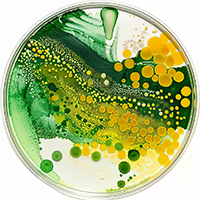Scientific Posters
Zymo Research's scientific posters highlight the latest breakthroughs in molecular biology, showcasing innovations spanning from epigenetics to microbiomics. We are proud to present insights from our collaborations with leading scientists and institutions worldwide, with more contributions to the field of life science on the horizon.
Featured Poster

An Integrated Approach for Pathogen Detection, AMR Monitoring, and Functional Analysis in Wastewater
X. Cheng , J. Wilkinson, K. Ngo , P. Baybayan, Y. Kim, P. Pham, E. Carrasco, S. Tang, J. Shen, and K. LockenWastewater surveillance has emerged as a pivotal tool in public health epidemiology. Particularly catalyzed by the Covid-19 pandemic, modern culture-independent sequencing methods have become indispensable due to their ability to offer a comprehensive perspective.
View PosterA Fully Automated Workflow for High-Throughput Purification of Transfection-Grade Plasmid
Joshua Lee, Zoë Hermsen & Aaron ClausenTransfecting mammalian cells with plasmid DNA has become a critical tool for studying biological processes, developing therapeutics, gene editing, producing proteins, and generating recombinant viruses. While advances in DNA synthesis have simplified the construction of variant gene libraries for evaluating candidates of interest with transfection, purifying transfection-grade plasmid remains a major bottleneck for high-throughput screening. Traditionally, plasmid that meets the quantity, concentration, and low endotoxin requirements for mammalian cell transfection is prepared from large volumes of overnight E. coli culture using slow gravity flow anion-exchange columns and lengthy alcohol precipitation steps, making the process poorly suited for high-throughput and automated processing. To address this issue, Zymo Research developed a patented DNA purification method that is capable of purifying high amounts of transfection-grade plasmid from small volumes of overnight culture using silica coated magnetic beads. When combining this method with specialized magnetic particles that efficiently remove cellular debris following lysate neutralization, there is no need for centrifugation, making the plasmid purification process easy to completely automate using commercially available liquid handlers.
View PosterSimplifying Multigene Vector Design and Construction for Streamlined Development of Complex Therapeutics
Zoë Hermsen, Joshua Lee, Aaron Clausen, Sam Glickstein & Thomas D. ReedMolecular therapeutics have revolutionized personalized medicine by offering long-lasting, low-risk alternatives to traditional treatments. Many fatal diseases, including heart disease, neurodegeneration, and cancer involve multiple, complex regulatory pathways that necessitate multigenic therapeutic approaches rather than conventional monogenic solutions for molecular therapy. However, the development of multigenic vectors is often hindered by high costs, lack of precision, off-target effects, and tedious troubleshooting of vector design and construction. Furthermore, the complexity and size of multigenic vectors is challenging for modern DNA synthesis techniques, so traditional time-consuming and cumbersome cloning techniques are necessary for creating recombinant multigenic vectors. To address these challenges, Osprey Bio’s Bird of Prey complex vector system provides a standardized, cost-effective method for tunable multigenic vector assembly using modular genetic units, making multigenic vector design as simple as traditional single gene vector design. In this study, we leveraged the Bird of Prey vector construction system in conjunction with Zymo Research’s highly efficient cloning technology to construct a quadgene vector incorporating four distinct reporter genes: rLUC, fLUC, GFP and RFP. Functionality of the multigenic vectors were then assessed by evaluating the expression of the reporter genes in HEK293T cells.
View PosterAssessing HiFi Long Read Sequencing versus Whole Genome Bisulfite Sequencing and Methylation EPIC BeadChip Array A Comparative Analysis Utilizing DNA Methylation Standards
Ryan Yancey, Angele De Silva, Jeffrey Bhasin, Keith Booher, Xiaojing Yang, Larry JiaDNA methylation, one of the most abundant and extensively studied epigenetic modifications, plays crucial roles in various biological processes such as development, cancer, aging, and complex diseases. The Illumina array has been widely employed.
View PosterA Method for Quantifying DNA Methylation Percentage Without Chemical Modification
Michael Karberg, Ron J. Leavitt, Danice Anne A. Cabaya, Marc E. Van Eden and Xi Yu JiaAltered DNA methylation patterns have been associated with aberrant gene expression and the onset of some diseases, including cancer. The ability to quantify DNA methylation in normal and diseased...
View PosterA Novel Way to Control PCR Chimera in the Library Preparation of 16S Targeted Sequencing
Mikayla Mager, Shuiquan Tang, and Xi Yu JiaAn increasingly important application of microbiomics is how the microbes living in and on humans affect us, for better or worse. With the innovation of long-read sequencing as well as...
View Poster
